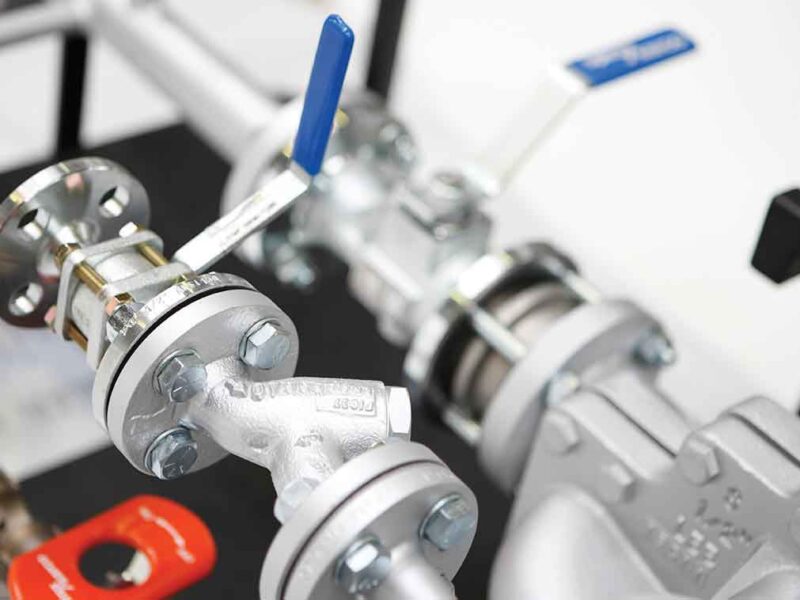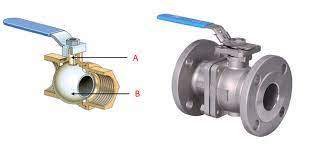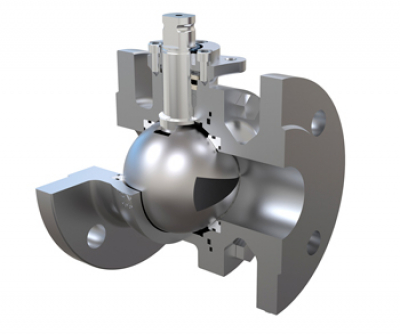
What is the ball valve construction?
BCST ball valves have many different structures but are similar. They all have a round ball core as the opening and closing members. The ball valve mainly comprises the valve seat, ball, seal, stem, and other driving devices. It is turned 90 degrees by the stem to open and close the valve. The ball valve is used in the pipeline to shut off, distribute, adjust the flow size and change the flow direction of the medium. The valve seat is sealed differently according to the working conditions.
What are the differences between O- and V-shaped ball valves?
BCST O-Ball Valve:
BCST O-shaped ball valve can act as a regulator and cut-off. It is often used for two-position control. The O-Ball valve is particularly suitable for high viscosity, suspensions, pulp, and other fluids. It has a reliable seal with minimal leakage. And the soft seal ball valve can achieve bubble-level sealing.
BCST O-Ball Valve Structure:
The BCST O-Ball valve has a ball with a hole in the middle inside the valve body. The diameter of the hole, however, is equal to the diameter of the pipe. It can rotate the ball inside the valve seat. And it will be sealed on each side in the direction of the tube by an annular elastomer. The ball valve can be opened and closed by turning the ball 90° to change the direction of the through-hole. The relative moving parts of the valve are made of self-lubricating materials with a very low coefficient of friction. As a result, the O-ball valve has low operating torque. In addition, the long-term sealing of the sealing grease makes it more flexible in operation.

The advantages of O-Ball Valve are shown below.
1.O-ring ball valves have low fluid resistance.
BCST ball valves are generally available in two structures: through bore and reduced bore. Regardless of the construction, ball valves have a relatively small coefficient of flow resistance.The conventional ball valve is a straight-through type, also known as a complete flow type ball valve. Its passage diameter is equal to the inner diameter of the pipe, and the resistance loss is only the frictional resistance of the same length of the line. This type of ball valve has the lowest fluid resistance of all the valves. Two approaches can be used to reduce the resistance of a piping system. The first is to reduce the flow rate of the fluid. It is done by increasing the pipe diameter and valve diameter, which will significantly increase the cost of the piping system. The second is to reduce the local resistance of the valve, and the ball valve is the best choice.
2.O-ring ball valves are quick and easy to open and close.
BCST ball valve can be opened or closed quickly as it only needs to be turned 90 degrees to be fully open or closed.
3.O-ball valve has good sealing performanc
Most ball valve seats are manufactured using resilient materials such as PTFE, which we usually refer to as soft seal ball valves. Soft seal ball valves have a better sealing performance and do not require high roughness and machining accuracy on the sealing surface of the valve.
4.O-Ball valve offers long life.
Due to the excellent self-lubrication of PTFE, the coefficient of friction with the ball is small. In addition, the improved processing reduces the roughness of the ball, thus greatly increasing the service life of the ball valve.
5.O-Ball valves are highly reliable.
Metal hard seal O type fixed ball valve adopts bi-directional metal movable sealing structure, with automatic compensation function and superior sealing performance.
The O-type fixed ball valve has a fixed ball design with a different preload spring, giving the ball valve an automatic pressure relief function.
Each ball valve has two movable sealing seats, which can seal in both directions. Thus the flow direction of the medium does not need to be considered during installation.
BCST O-ball valve has a fireproof and anti-static structure. With conductive springs between stem and body and stem and ball, it can avoid ignition of flammable media by static ignition. Thus ensuring system safety.
It has a fire-resistant structure for double protection. However, in case of fire and the seal is burnt, all parts of the ball valve can form a metal-to-metal hard seal structure.
It comes with an automatic pressure relief structure. When the liquid medium trapped in the valve cavity is vaporized due to an increase in temperature, the pressure in the cavity rises abnormally. At this time, the medium in the cavity can rely on its thrust to push the valve seat and automatic pressure relief, thus ensuring the safety of the valve.
BCST V-Ball Valve:
The BCST V-shaped ball valve is a fixed and single-seat sealed ball valve. It has the best regulating performance of any ball valve. Its flow characteristics are equal percentage and adjustable up to 100:1. It has a shearing effect between the V-cut and the metal seat. Therefore, it is particularly suitable for media containing fibers, tiny solid particles, slurries, etc.
BCST V-Ball Valve Structure:
The BCST V-ball valves have a V-shaped spool with a 1/4 ball housing and a V-notch. It has a large flow capacity and a large adjustable range. It also has a shear force and can be closed tightly. Therefore, it is particularly suitable for applications where the fluid substance is fibrous. In general, the V-ball valve is a single-seal ball valve. Consequently, it is not ideal for use in both directions.
During the rotation of the ball, the V-shaped cutter of the ball is tangential to the seat, thus cutting off fibers and solids in the fluid. The typical ball valve does not have this function, so it is easy to cause fibrous impurities to get stuck when closing. It can cause great inconvenience to repair and maintenance. The V-ball valve has a spool that is not trapped by fibers. In addition, the flange connection makes it easy to dismantle and install. It requires no special tools and is easy to repair and maintain. The V-notch creates a covenant scissor effect with the valve seat when the valve is closed. And it also has a self-cleaning function, which in turn prevents the ball core from seizing. The valve body, cover, and seat are metal point-to-point construction. In addition, it uses a valve stem spring with a low coefficient of friction. As a result, it has a low operating torque and is very stable.

The BCST V-ball valve is a right-angle rotary structure. It enables a flow regulating action. We can achieve different degrees of proportionality depending on the V angle of the V-ball. V-ball valves are generally used with valve actuators and positioners to achieve proportional adjustment. V-ball spool is most suitable for various regulating situations. It has a large rated flow coefficient, adjustable ratio, and a good sealing effect. It has zero-sensitive regulating performance and small volume. You can also install it vertically. It is suitable for controlling media such as gas, steam, liquid, etc. The V-shaped ball valve is a right-angle rotary structure. It consists of a V-shaped valve body, a pneumatic actuator, a positioner, and other accessories. It has an inherent flow characteristic of an approximately equal percentage ratio. It has a double-bearing construction and a low starting torque. It also has excellent sensitivity and sensing speed with superb shear capability.






